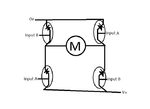Resistanceisfutile
Member level 4
So I was wondering whether this circuit (apologies for the awful paint drawing) would allow me to control a motor in two directions?
(If there are any other nessecary components please tell me.)

Just for clarification, I'm asking whether when input A or B was high (and the other input was low) would the motor turn properly?
(If there are any other nessecary components please tell me.)

Just for clarification, I'm asking whether when input A or B was high (and the other input was low) would the motor turn properly?